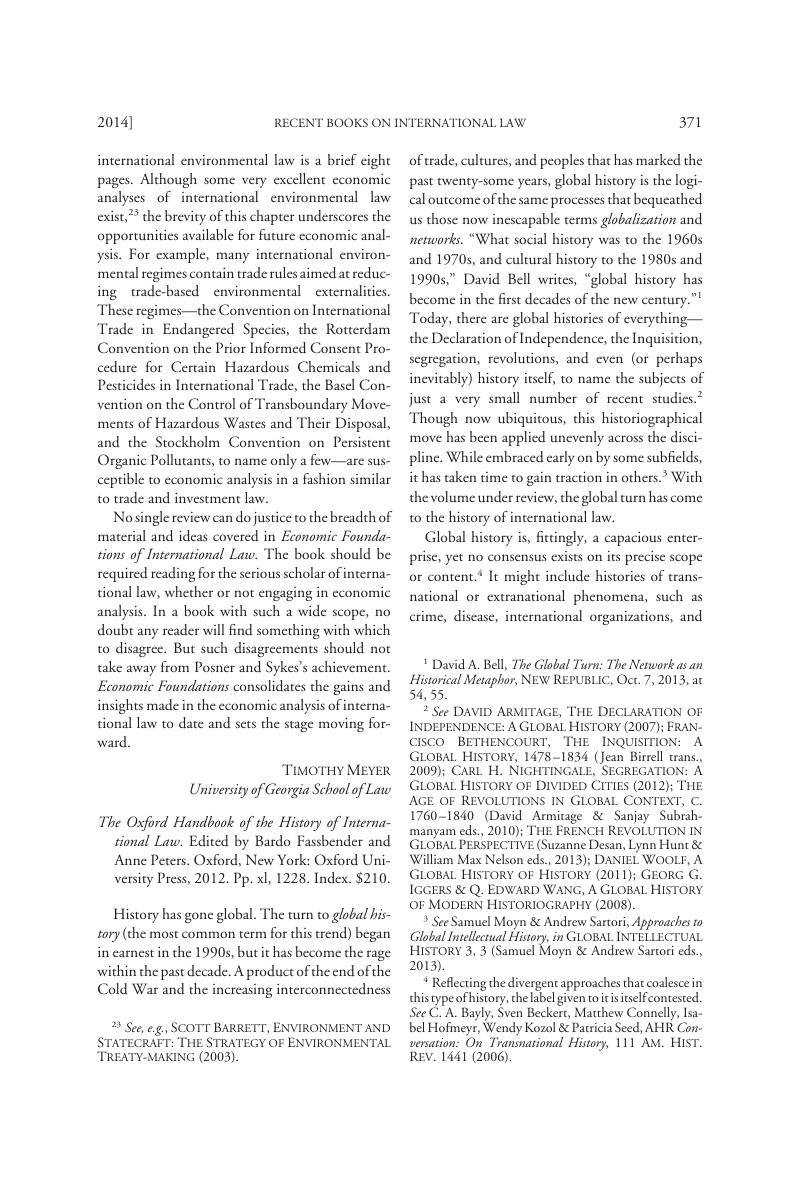No CrossRef data available.
Article contents
The Oxford Handbook of the History of International Law. Edited by Bardo Fassbender and Anne Peters. Oxford, New York: Oxford University Press, 2012. Pp. xl, 1228. Index. $210.
Published online by Cambridge University Press: 20 January 2017
Abstract

- Type
- Recent Books on International Law
- Information
- Copyright
- Copyright © American Society of International Law 2014
References
1 Bell, David A., The Global Turn: The Network as an Historical Metaphor, New Republic, Oct. 7, 2013, at 54, 55Google Scholar.
2 See David Armitage, The Declaration of Independence: A Global History (2007); Francisco Bethencourt, The Inquisition:A Global History, 1478–1834 (Jean Birrell trans., 2009); Carl H. Nightingale, Segregation: A Global History of Divided Cities (2012); The Age of Revolutions in Global Context, c. 1760–1840 (David Armitage & Sanjay Subrahmanyam eds., 2010); The French Revolution in GLOBAL PERSPECTIVE (Suzanne Desan, Lynn Hunt & William Max Nelson eds., 2013); Daniel Woolf, A Global History of History (2011); Georg G. Iggers & Q. Edward Wang, A Global History of Modern Historiography (2008).
3 See Moyn, Samuel & Sartori, Andrew, Approaches to Global Intellectual History, in Global Intellectual History 3, 3 (Moyn, Samuel & Sartori, Andrew eds., 2013)CrossRefGoogle Scholar.
4 Reflecting the divergent approaches that coalesce in this type of history, the label given to it is itself contested. See Bayly, C. A., Beckert, Sven, Connelly, Matthew, Hofmeyr, Isabel, Kozol, Wendy & Seed, Patricia, AHR Conversation: On Transnational History , 111 Am. Hist. Rev. 1441 (2006)CrossRefGoogle Scholar.
5 See, e.g., Patricia Clavin, Securing the World Economy: The Reinvention of the League of Nations, 1920–1946 (2013); Daniel Gorman, The Emergence of International Society in the 1920s (2012).
6 See, e.g., Mary Sarah Bilder, The Transatlantic Constitution: Colonial Legal Culture and the Empire (2004); Pacific Histories: Ocean, Land, People (David Armitage & Alison Bashford eds., 2014); Margins to Mainstream: The Brave New World of Borderlands History, 98 J. Am. Hist. 337 (2011) (special symposium section); Adelman, Jeremy & Aron, Stephen, From Borderlands to Borders: Empires, Nation-States, and the Peoples in Between in North American History, 104 Am. Hist. Rev. 814 (1999)CrossRefGoogle Scholar.
7 See, e.g., Daniel T. Rodgers, Atlantic Crossings: Social Politics in a Progressive Age (1998).
8 See, e.g., Amand a Foreman, A Worldon Fire: Britain’s Crucial Role in the American Civil War (2010); Eliga H. Gould, Among the Powers of the Earth:The American Revolution and the Making of a New World Empire (2012); Steve Pincus, 1688: The First Modern Revolution (2009).
9 See, e.g., Mark Mazower, No Enchanted Palace:The End of Empire and the Ideological Origins of the United Nations (2009); Mark Mazower, Governing the World: The History of an Idea (2012); Glenda Sluga, Internationalism in the Age of Nationalism (2013).
10 Armitage, David, The International Turn in Intellectual History, in Foundations of Modern International Thought 17, 18 (2013)Google Scholar.
11 Bailyn, Bernard, How England Became Modern: A Revolutionary View, N.Y. Rev. Books, Nov. 19, 2009, at 44, 44Google Scholar (reviewing Pincus, supra note 8).
12 Bell, supra note 1, at 55.
13 The topic “Eurocentrism in the History of International Law” is well chronicled in Arnulf Becker Lorca’s contribution.
14 Neff, Stephen C., A Short History of International Law, in International Law 3, 3 (Evans, Malcolm D. ed., 3d ed. 2010)CrossRefGoogle Scholar.
15 See, e.g., Grewe, Wilhelm G., The Epochs of International Law (Byers, Michael trans., 2000) (1984)CrossRefGoogle Scholar; Douglas M. Johnston, The Historical Foundations of World Order:The Tower and the Arena (2008); Arthur Nussbaum, A Concise History of the Law of Nations (1947).
16 See, e.g., Mark Weston Janis, The American Tradition of International Law: Great Expectations, 1789–1914 (2004); International Law in the U.S. Supreme Court: Continuity and Change (David L. Sloss, Michael D. Ramsey & William S. Dodge eds., 2011).
17 John Witt calls the writings of these critical scholars “outsider doctrinalist histories.” John Fabian Witt, A Social History of International Law: Historical Commentary, 1861–1900, in International Law in the U.S. Supreme Court, supra note 16, at 164, 178.
18 See, e.g., Mónica García-Salmones Rovira the Project of Positivism in International Law (2013); Martti Koskenniemi, The Gentle Civilizer of Nations: The Rise and Fall of International Law, 1870–1960 (2001); Research Handbook on the Theory and History of International Law (Alexander Orakhelashvili ed., 2011); Richard Tuck, The Rights of War and Peace: Political Thought and the International Order from Grotius to Kant (1999); Pitts, Jennifer, Empire and Legal Universalisms in the Eighteenth Century, 117 Am. Hist. Rev. 92 (2012)CrossRefGoogle Scholar. Indeed, Oxford University Press recently launched a book series on “The History and Theory of International Law.” See http://ukcatalogue.oup.com/category/academic/series/law/htil.do.
19 See Mazower, Mark, The Strange Triumph of Human Rights, 1933–1950, 47 Hist. J. 379, 380 (2004)CrossRefGoogle Scholar (“Lawyers... shy away from any hint that the origins of legal regimes lie in a set of cultural, political, and ideological struggles....”).
20 Witt, supra note 17, at 177;see also Mazower, supra note 19, at 380 (“[T]he history of how law has been deployed in international politics remains a ghetto within a ghetto.”).
21 See, e.g., Lauren Benton, A Search for Sovereignty:Law and Geography in European Empires, 1400–1900, at 112–20 (2010) (pirates as lawyers).
22 See, e.g., Elizabeth Borgwardt, A New Deal for the World: America’s Vision for Human Rights (2005); Clavin, supra note 5; Peter Holquist, “By Right of War”: The Discipline and Practice of International Law in Imperial Russia, 1868–1917 (forthcoming); Isabel V. Hull, A Scrap of Paper: Breaking and Making International Law During the Great War (forthcoming 2014); Mazower, No Enchanted Palace, supra note 9; Samuel Moyn, The Last Utopia: Human Rights in History (2010); James Q. Whitman, The Verdict of Battle: The Law of Victory and the Making of Modern War (2012); John Fabian Witt, Lincoln’s Code: The Laws of War in American History (2012); Hirsch, Francine, The Soviets at Nuremberg: International Law, Propaganda, and the Making of the Postwar Order, 113 Am. Hist. Rev. 701 (2008)CrossRefGoogle Scholar; Pedersen, Susan, Back to the League of Nations, 112 Am. Hist. Rev. 1091 (2007)CrossRefGoogle Scholar.




